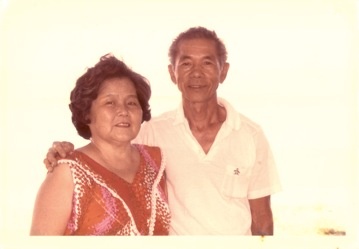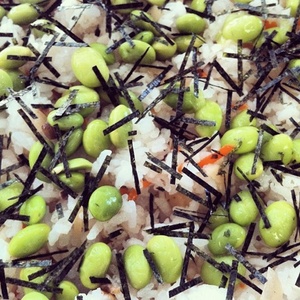Standing in the kitchen grinding on bright yellow takuan straight out of the container takes me right back to my grandparents’ house in Palolo Valley, an older, predominantly Japanese-American neighborhood on the island of Oahu. Palolo was one of the few sections of Honolulu I knew of where there were “projects.” When the song “Electric Avenue” became a hit, we kids changed the lyrics to: “We gonna walk down to Palolo Avenue, and then we’ll take your tires.” It wasn’t unusual to see a car parked on the side of the road almost completely stripped.
Growing up in Honolulu, I was called hapa haole. Hapa haole girls are said to be some of the most beautiful, at least that’s what I was given to understand, and yet the whole time I thought I was just one funny looking wahine.
My Hungarian-Irish father sailed into Honolulu’s Ala Wai Yacht Harbor in 1965, after partially circumnavigating the globe, mostly by himself. He met my mother, at the time a 21-year-old hazel-eyed local beauty of “pure” Japanese descent, and decided the rest of the world couldn’t possibly be worth leaving this paradise for.
There was always some tension between our family and my mother’s parents. My mother’s transgression was not just that she took up with a haole, but with a haole foreigner, who in their eyes had little to show except the boat he sailed in on and a whole lot of book learning. Who was this stranger who whisked away their daughter from her family and her schooling to live a bohemian beatnik boating life in a bikini? At the time, he was a bilingual Sorbonne and Strand College educated former journalist and professor of Romantic poetry turned yachtsman.
Food was the vehicle by which many of these tensions were transcended.
Takuan, tsukudani, furikake on rice, barazushi, red bean rice, cucumber kim chee, pickled lotus root, shoyu butterfish, shrimp roll, ogo, dried tako, sushi rolls—these were some of the delicacies I could expect when paying a visit to my grandparents’ house.
My grandparents were simple, hard-working people. My grandmother, Ruth Nakakura, came from a family of eight children. She was orphaned at the age of 14, when she had to quit school to work and help take care of her younger siblings, three of whom were adopted by another Japanese family on Maui. My grandmother learned to read and write in Japanese because she worked as a typesetter for The Hawai‘i Herald—the Japanese American newspaper of Hawaii.
My grandfather, Peter Nishio, was a juvenile delinquent who took up boxing and fought under the pseudonym Nishi instead of Nishio, because his mother thought boxing dishonored the family name. When his young father died from the Spanish flu, my grandfather dropped out of school in the ninth grade. Under the iron fist of his mother—a barber, tailor, and healer—he eventually got his act together, became a house painter and, after a few arranged meetings with eligible young ladies, chose my grandmother and was married. Until his mother Tsune died, he handed his paychecks over to her. When she was gone, he gave them to his wife.

My grandparents, great cook Ruth Shizue and Peter Yuichi Nishio in the 1980s. Credit: Matthew FitzGerald.
It wasn’t until I was in college that I realized the only grandparents I knew, my mother’s parents, weren’t going to live forever. Their stories and knowledge would die with them. What made this realization strike even harder was the thought of never tasting my grandmother’s cooking again—no more sushi, no more butterfish, no more cucumber kim chee, no more fried chicken with green onions, no more shrimp roll. Aie ya! I decided to ask my grandmother to teach me.
My grandmother managed to talk almost nonstop, but never said a bad word about anybody. She was always doing for others in the family, who wanted her sushirolls because they were the best. Whenever I would visit, she nattered and chattered, all the while opening containers and bringing out small bowls of mostly homemade local delicacies. Once the food was served, she’d sit at the table talking some more, her hands brushing circles over the vinyl-covered tabletop.
A year after my birth, my mother, father, brother, and I became landlubbers, moving from Typee, the 35-foot sailboat we lived on, to a dilapidated house on the beach. While I was growing up, my grandfather would come almost every week to harvest ogo from the ocean and catch octopus. I once witnessed him in an epic battle with this creature. Standing at the shoreline, he had some of its tentacles in his outstretched arms and the rest of it suctioned to his back, its black ink running down his bare skin.
There is no more delicious tako than the octopus my grandfather salted and sundried on the windowsills at the house in Palolo. I have never had such delicious seaweed as the ogo picked at Paiko Beach, boiled for just a few seconds, then bottled with shoyu, ginger, and garlic.

My barazushi today with soybeans on top—a slight departure from the original. Credit: Lee-Roy Lahey.
The first recipe my grandmother taught me was how to make barazushi, which includes most of the ingredients that go into a sushi roll, but tossed loosely into sushi rice instead of rolled up and neatly sliced. I still have the yellowed piece of paper with her handwriting on it: for 3 cups of cooked rice use 1/3 cup sugar with 1/3 cup vinegar boiled and cooled, then tossed with the cooked rice. For the shiitake mushrooms: simmer with sugar and light shoyu, then drain. Add chopped scrambled eggs, carrots, and ginger. I remember her saying to me repeatedly: “You gotta wash da rice, wash da rice.” I didn’t have the heart to tell her that I at least already knew how to make rice!
The only other recipe there was time for her to pass on to me was for tsukudani—seasoned seaweed. Put all your old nori in a pot, wet with water, drain out, add shoyu and brown sugar, 3 tablespoons sake, turn on stove, heat/stir/mash, taste, “add extra for taste,” add chili pepper and salt. I never have enough “old nori” lying around to make my own tsukudani, but when I buy it ready-made at the store, I take pleasure in the memory of making it with my grandmother.
The other thing I did before my grandparents passed away was record them talking about their past—their parents, their siblings, their community. I learned how hard their lives were and how hard they worked. Now that I’m a parent, I know that though they were not demonstrative in their love for their own children, they did the best they could with the resources they had.
Nikkei is a relatively new concept to me. I first heard the term when I was spending a lot of time visiting my boyfriend (now my husband) who had an apartment in Los Angeles’ Little Tokyo, right across from a community center that served, among others, the nikkei community. I wondered: Am I nikkei?
The truth is, for most of my life, I never felt Asian enough. As I’ve grown older, I identify more strongly as a person of mixed ancestry, which is after all what I am. I suppose I identified more with haoles as a young person. But as an adult, I realize that I have spent my life “fitting in” nowhere.
Now that I am a mother to a hapa hapa haole daughter, who my haole husband and I gave the Japanese name Kohana, I embrace all aspects of my heritage. I realize it is neither “less” to be part European, nor is it “less” to be part Japanese. In fact, I get the best of both worlds. I used to feel guilty that I loved French literature so much, that it was politically incorrect for a person from Hawaii to be so Western, but I was set straight by my poetry teacher Marilyn Chin, who told me: That is part of your experience—you were brought up by a European father—that is your ancestry, that is yours. She was not ashamed of me.
What I have learned as an adult, as a mother and a professional woman is that the more understated side of my upbringing—from my mother, my aunt, my grandmother, and grandfather—was also an influence, one that I can give full credit to now that I have come into my own.
© 2012 Jamie Asaye FitzGerald



